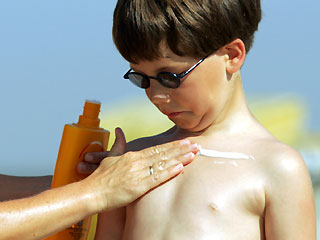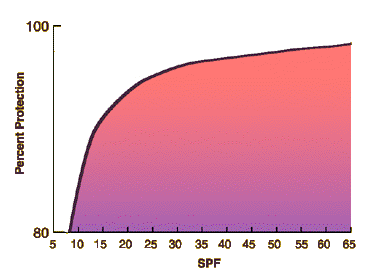Preventing the Harmful Effects of Ultraviolet Radiation
Sun Protection Factor (SPF)
Sunscreens provide partial protection from ultraviolet rays, but they vary in their ability to block UVA and UVB rays. Products vary in their composition, but in general, they contain chemicals that absorb, reflect, or scatter light. Reddening and burning of the skin has been attributed primarily to UVB rays, while UVA penetrates deeper and is thought to be more responsible for photoaging and skin cancer. Nevertheless, the effects of UVA and UVB are largely the same, and products vary in their ability to block UVA and UVB.
A sunscreen's effectiveness is commonly measured by its sun protection factor, or SPF. SPF is not an amount of protection per se. It indicates how long it will take for UVB rays to redden skin when using a sunscreen, compared to how long skin would take to redden without the product. For instance, someone using a sunscreen with an SPF of 15 will take 15 times longer to redden than without the sunscreen. An SPF 15 sunscreen screens 93 percent of the sun's UVB rays; SPF 30 protects against 97 percent; and SPF 50, 98 percent. The Skin Cancer Foundation maintains that SPFs of 15 or higher are necessary for adequate protection.
Sunscreen wears off with time, and its efficacy diminishes substantially with swimming or when perspiring. Consequently, it is important to reapply it at least every two hours and more frequently if you are swimming or sweating.


Resources and Programs to Promote Prevention
The US Environmental Protection Agency (EPA) has an informative web page as part of their Sunwise Program that provides an overview of various harmful effects of excessive sun exposure. This page also provides links that explain the UV Index, how the index is calculated, and a UV Index Widget that tells you the UV Index in your ZIP code. The SunWise Program also has value links that provide information for schools and educators, for kids, and for communities, and their is information in Spanish as well.
An online video Public Service Announcement that provides an engaging message for the general public can be found here. (Created by students at Boston University School of Public Health.)
This link is to an article on sun safety written for the Watertown Health Department. It is an illustration of the kind of public service information that might be sent to local newspapers. The article was written by Ramya Kumar, an MPH candidate at Boston University School of Public Health.



